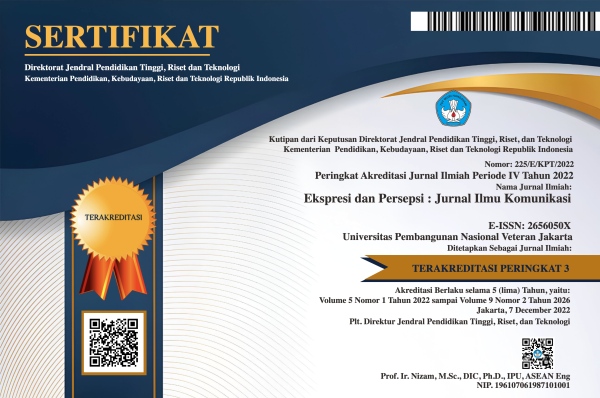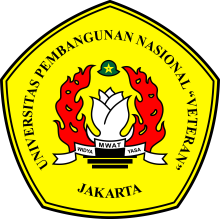Swifties Experience: Examining Taylor Swift The Eras Tour (2023) Movie as Concert Mediatization
DOI:
https://doi.org/10.33822/jep.v7i3.8381Keywords:
Concert, Concert-feel-like activity, mediatization, social space, The Eras Tour movieAbstract
This research examines Taylor Swift’s concert documentary movie called The Eras Tour (2023) that created a shift in audience’s cinema experience by not customarily watching a movie but emerge themselves which resulting in a ‘concert-feel- like’ activity. This study shows an alternative and complement live performance and streaming technology that previously researched by Scherzinger (2019) as music distribution method. Using Hjarvard’s concept of mediatization and Harvey’s theory of the production of space, I analyze how this movie concert influences audience interactions which create a new social space within cinema. Data were collected through interviews and social media documentation to examine the watching experience of The Eras Tour (2023) movie. This research finds that this mediatized concert acts as an incomplete substitution for live performances, positioning cinema as a concert space due to the implications of mediatization. Additionally, the research reveals that audience interactions beyond merely watching the movie demonstrate an amalgamation process that fosters solidarity within the fandom. Interestingly, this phenomenon generally ‘breaks the rules’ of traditional cinema logic due to the amalgamations that occur. Thus, this research shows that the mediatized concert acts as an incomplete substitution of live performance, which contribute to modern practice of mediatization in media and music industry.
References
Asp, K. (2014). Mediatization: rethinking the question of media power. In Knut Lundby, Mediatization of Communication. De Gruyter Mouton.
Barton, G. (2018). The relationship between music, culture, and society: Meaning in music. In Georgina Barton, Music Learning and Teaching in Culturally and Socially Diverse Contexts: Implications for Classroom Practice. Palgrave MacMillan.
Biocca, F. (1988). Opposing Conceptions of the Audience: The Active and Passive Hemispheres of Mass Communication Theory. Annals of the International Communication Association, 11(1), 51–80. https://doi.org/10.1080/23808985.1988.11678679
Boggs, J. M., & Petrie, D. W. (2008). The Art of Watching Films. Mayfield Pub.
Cain, S. (2023). The Eras Tour film has already grossed more than $100m. The Taylor Swift
economy is unstoppable. BBC News.
Certeau, M. de. (1984). The Practice of Everyday Life. University of California Press.
Connolly, S. (2017). The Spatial Cinema: An Encounter between Lefebvre and the Moving
Image. PhD by Research as Practice University of Kent.
Couldry, N. (2014). Mediatization and the future of field theory. In Knut Lundby, Mediatization
of Communication. De Gruyter Mouton.
Dahlberg, K. H., Dewind, S., Geerling, W., Green, A., & Mateer, G. D. (2024). Swiftonomics: Using Taylor Swift to Teach Supply and Demand and Foreign Exchange Rates. Available at SSRN https://ssrn.com/abstract=4721864 or http://dx.doi.org/10.2139/ssrn.4721864
Edlom, J., & Karlsson, J. (2021). Sic fandom and the motivations of superfans. Media and Communication, 9(3), 123–132. https://doi.org/10.17645/mac.v9i3.4013
Farzand, M. (2023). Documentary as an Art Form: The Intersection of Reality and Aesthetics Title: “Documentary as an Art Form: The Intersection of Reality and Aesthetics.” Retrieved from https://www.researchgate.net/publication/374695332
Farzand, M. (n.d.). Title: Documentary as an Art Form: The Intersection of Reality and Aesthetics Title: “Documentary as an Art Form: The Intersection of Reality and Aesthetics.” Retrieved from https://www.researchgate.net/publication/374695332
Firmansyah, D., Lubis, D. P., Muljono, P., & Purnaningsih, N. (2024). Process of Adopting Information and Communication Technology (ICT) Innovations in Vocational Learning for Autism Spectrum Disorder (ASD) Students during the Covid-19 Pandemic. EKSPRESI DAN PERSEPSI : JURNAL ILMU KOMUNIKASI, 7(2), 313–328. https://doi.org/10.33822/jep.v7i2.6295
Fuchs, C. (2020). Everyday Life and Everyday Communication in Coronavirus Capitalism. TripleC-Communication, Capitalism, & Critique: Journal for a Global Sustainable Information Society. Vol. 18(1). 375-399.
Fuchs, C. (2024). Media, Economy and Society; A Critical Introduction. Routledge.
Hanich, J. (2018). The Audience Effect on The Collective Cinema Experience. Edinburgh
University Press.
Harvey, D. (2004). Space as a Key Word. Paper for Marx and Philosophy Conference, Institute
of Education, London.
Hepp, A., & Hitzler, R. (2014). Collectivities in change: The mediatization and individualization
of community building from a subjective and figurational perspective. In L. Kramp, et al. (Eds.), Politics, Civil Society and Participation: Media and Commu-nications in a Transforming Environment. Edition Lumière.
Hepp, A., Hjarvard, S., & Lundby, K. (2015). Mediatization: theorizing the interplay between media, culture and society. Media, Culture and Society, 37(2), 314–324. https://doi.org/10.1177/0163443715573835
Hepp, A., & Krotz, F. (2014). Mediatized worlds: Culture and society in a media age. Palgrave MacMillan.
Hjarvard, S. (2008). The Mediatization of Society. Nordicom Review, 29(2), 102–131. https://doi.org/10.1515/nor-2017-0181
Jansson, A. (2013a). Mediatization and social space: Reconstructing mediatization for the transmedia age. Communication Theory, 23(3), 279–296. https://doi.org/10.1111/comt.12015
Junior, A. D. S. (2014). Urban common space, heterotopia and the right to the city: Reflections on the ideas of Henri Lefebvre and David Harvey. URBE - Revista Brasileira de Gestão Urbana, 6(541), 146. https://doi.org/10.7213/urbe.06.002.se02
Kaun, A., & Fast, K. (2014). Mediatization of culture and everyday life. Södertörns högskola. Krämer, B. (2011). The Mediatization of Music as the Emergence and Transformation of Institutions: A Synthesis. International Journal of Communication. Vol. 5: 471-491.
Retrieved from http://ijoc.org.
Löblich, M. (2018). The History of Media Policy Based on Mediatization: A Theoretical
Perspective. International Journal of Communication. Vol. 12: 4468-4487. Retrieved from
Marsh, C. (2023). The Secret Art of Turning a Concert into a Film (Taylor’s Version). In
https://www.nytimes.com/2023/10/13/movies/taylor-swift-eras-tour-concert-film.html Mayne, J. (2002). Cinema and Spectatorship. Routledge.
Mazzoleni, G. (2017). Changes in contemporary communication ecosystems ask for a “new
look” at the concept of mediatisation. Javnost, 24(2), 136–145.
https://doi.org/10.1080/13183222.2017.1290743
McLuhan, M., & Gordon, W. T. (2003). Understanding media: the extensions of man. Gingko
Press.
Merskin, D. L. (2020). Documentary Media. In The SAGE International Encyclopedia of Mass
Media and Society. SAGE Publications, Inc.
https://doi.org/10.4135/9781483375519.n199
Michelsen, M., & Krogh, M. (2017). Music, radio and mediatization. Media, Culture and Society,
(4), 520–535. https://doi.org/10.1177/0163443716648494
Miles, M. B., Huberman, A. M., & Saldaña, J. (2014). Qualitative Data Analysis A Methods
Sourcebook. Sage Publication.
Mosco, V. (2009). The Political Economy of Communication. Sage Publication.
Muhammadali, N. (2014). Introduction to Mass Communication. Mass Communication
Complementary Course for BA English. University of Calicut.
Nie, K. S., Kee, C. P., & Ahmad, A. L. (2014). Mediatization: A Grand Concept or Contemporary
Approach? Procedia - Social and Behavioral Sciences, 155, 362–367.
https://doi.org/10.1016/j.sbspro.2014.10.306
Pontara, T., & Volgsten, U. (2017). Musicalization and Mediatization. In Transforming
Communication (pp. 247–269). Palgrave Macmillan. https://doi.org/10.1007/978-3-319-
-4_12
Puspapertiwi, E. R., & Pratiwi, I. E. (2023). Film “Taylor Swift the Eras Tour” Tayang di Indonesia
Mulai 3 November 2023, Berapa Harga Tiketnya? Retrieved from https://www.kompas.com/tren/read/2023/10/22/181500865/film-taylor-swift-the-eras- tour-tayang-di-indonesia-mulai-3-november- 2023?page=all#:~:text=Harga%20tiket%20film%20Taylor%20Swift%20The%20Eras%20 Tour%20di%20Indonesia&text=Sementara%20tiket%20film%20ini%20akan,dibuka%20 mulai%2027%20Oktober%202023.
Ravazzoli, E. (2016). Cinemagoing as Spatially Contextualised Cultural and Social Practice. Alphapille: Journal of Film and Screen Media. Vol. 11, 33-44.
Scherzinger, M. (2019). The political economy of streaming. In The Cambridge Companion to Music in Digital Culture (pp. 274–297). Cambridge University Press. https://doi.org/10.1017/9781316676639.026
Schulz, W. (2004). Reconstructing Mediatization as an Analytical Concept. European Journal of Communication, 19(1), 87–101. SAGE Publications Ltd. https://doi.org/10.1177/0267323104040696
Setiawan, A. H., & Lobodally, A. (2021). The Commodification of Celebrity Popularity Content in the Documentary Film “Miss Americana”. Jurnal Komunikasi dan Bisnis. Retrieved from http://eprints.kwikkiangie.ac.id/3218/9/resume.pdf
Vémola, J. (2009). Reflections of Marshall McLuhan’s Media Theory in the Cinematic Work of David Cronenberg and Atom Egoyan. Master’s Diploma Thesis of Faculty of Arts, Masaryk University.
Volgsten, U. (2021). Mediatization of music, musicalization of everyday life. In Phonographic Encounters (pp. 117–135). Routledge. https://doi.org/10.4324/9781003006497-9
Wiradharma, G., Ruliana, P., Prisanto, G. F., Anggraini, R., & Tinggi, S. (2021). Pemanfaatan Media Pembelajaran Daring dalam Proses Belajar Mengajar. Ekspresi dan Persepsi: Jurnal Ilmu Komunikasi, Vol. 4:(2), 157-172.
Downloads
Published
Issue
Section
License
Copyright (c) 2024 Alleyda Maharani Ambadar

This work is licensed under a Creative Commons Attribution-NonCommercial 4.0 International License.














